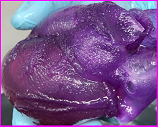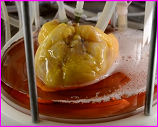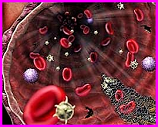Posted on February 4th, 2021 by Mary Lord
 Biomedical and tissue engineers are harnessing the power of 3-D printing, engineered bioinks, and novel materials with the aim of one day fabricating replacement hearts and other body parts.
Biomedical and tissue engineers are harnessing the power of 3-D printing, engineered bioinks, and novel materials with the aim of one day fabricating replacement hearts and other body parts.
Read More
Filed under: Special Features | Comments Off on The Beat Goes On with 3-D Bioprinting
Tags: 3-D bioprinting, Adam Feinberg, Biomedical Engineering, Carnegie Mellon University, heart, regenerative medicine, replacement body parts, tissue engineering
Posted on February 23rd, 2019 by Mary Lord
 The human body is an engineering marvel, but ligaments snap and organs fail. What if replacement parts could be grown in the lab – or by patients themselves? That’s the exciting frontier of tissue engineering and regenerative medicine that biomedical engineers, scientists, and physicians are exploring, with tantalizing results.
The human body is an engineering marvel, but ligaments snap and organs fail. What if replacement parts could be grown in the lab – or by patients themselves? That’s the exciting frontier of tissue engineering and regenerative medicine that biomedical engineers, scientists, and physicians are exploring, with tantalizing results.
Read More
Filed under: Special Features | Comments Off on Engineering Spare Body Parts
Tags: ASEE Prism magazine, biomechanical engineering, Biomedical Engineering, bioprinting, bioreactors, heart, organ transplant, regenerative medicine, STEM cell research, tissue engineering
Posted on February 14th, 2019 by Mary Lord
 Students in grades 3 to 5 learn about their heart rate and different ways it can be measured by constructing and using a simple device to measure their heart rate under different circumstances, such as sitting, standing, and jumping. They make predictions and record data on a worksheet.
Students in grades 3 to 5 learn about their heart rate and different ways it can be measured by constructing and using a simple device to measure their heart rate under different circumstances, such as sitting, standing, and jumping. They make predictions and record data on a worksheet.
Read More
Filed under: Class Activities, Grades K-5, Lesson Plans | Comments Off on The Beat Goes On
Tags: Biomedical Engineering, Class Activities, Grades K-5, Health, heart, Lesson Plan, NGSS aligned, pulse, stethoscope, teachengineering
Posted on February 8th, 2019 by Mary Lord
 In this activity, teams of students in grades 6 to 8 will learn about the engineering design process and how a one-way valve works by creating heart valves from tape, plastic tubing, and other materials.
In this activity, teams of students in grades 6 to 8 will learn about the engineering design process and how a one-way valve works by creating heart valves from tape, plastic tubing, and other materials.
Read More
Filed under: Class Activities, Grades 6-8, Grades 6-8, Grades 6-8, Grades 9-12, Lesson Plans | 1 Comment »
Tags: biomdedical engineering, Class Activities, device, Engineering Design Process, Grades 6-8, heart, Lesson Plan, Mechanical engineering, valve
Posted on January 11th, 2019 by Mary Lord
 In this NGSS-aligned activity, high school students work as biomedical engineers to find liquid solutions that can clear away polyvinyl acetate polymer “blood clots” in model arteries made of clear, flexible tubing. Teams create samples of the “blood clot” polymer to discover the concentration of the model clot and then test a variety of liquids to determine which most effectively breaks it down. Students learn the importance of the testing phase in the engineering design process, because they are only given one chance to present the team’s solution and apply it to the model blood clot.
In this NGSS-aligned activity, high school students work as biomedical engineers to find liquid solutions that can clear away polyvinyl acetate polymer “blood clots” in model arteries made of clear, flexible tubing. Teams create samples of the “blood clot” polymer to discover the concentration of the model clot and then test a variety of liquids to determine which most effectively breaks it down. Students learn the importance of the testing phase in the engineering design process, because they are only given one chance to present the team’s solution and apply it to the model blood clot.
Read More
Filed under: Class Activities, Grades 9-12, Lesson Plans | Comments Off on Let the Blood Flow: Biomedical Artery Unclogging Experiment
Tags: arteries, Biomedical Engineering, Chemistry, circulatory system, Class Activities, Grades 9-12, heart, Lesson Plan, NGSS, stent, TeachEngineeirng, UCLA SEEK GK-12 program, valves
 Biomedical and tissue engineers are harnessing the power of 3-D printing, engineered bioinks, and novel materials with the aim of one day fabricating replacement hearts and other body parts.
Biomedical and tissue engineers are harnessing the power of 3-D printing, engineered bioinks, and novel materials with the aim of one day fabricating replacement hearts and other body parts. 








 The human body is an engineering marvel, but ligaments snap and organs fail. What if replacement parts could be grown in the lab – or by patients themselves? That’s the exciting frontier of tissue engineering and regenerative medicine that biomedical engineers, scientists, and physicians are exploring, with tantalizing results.
The human body is an engineering marvel, but ligaments snap and organs fail. What if replacement parts could be grown in the lab – or by patients themselves? That’s the exciting frontier of tissue engineering and regenerative medicine that biomedical engineers, scientists, and physicians are exploring, with tantalizing results. Students in grades 3 to 5 learn about their heart rate and different ways it can be measured by constructing and using a simple device to measure their heart rate under different circumstances, such as sitting, standing, and jumping. They make predictions and record data on a worksheet.
Students in grades 3 to 5 learn about their heart rate and different ways it can be measured by constructing and using a simple device to measure their heart rate under different circumstances, such as sitting, standing, and jumping. They make predictions and record data on a worksheet. In this activity, teams of students in grades 6 to 8 will learn about the engineering design process and how a one-way valve works by creating heart valves from tape, plastic tubing, and other materials.
In this activity, teams of students in grades 6 to 8 will learn about the engineering design process and how a one-way valve works by creating heart valves from tape, plastic tubing, and other materials.  In this NGSS-aligned activity, high school students work as biomedical engineers to find liquid solutions that can clear away polyvinyl acetate polymer “blood clots” in model arteries made of clear, flexible tubing. Teams create samples of the “blood clot” polymer to discover the concentration of the model clot and then test a variety of liquids to determine which most effectively breaks it down. Students learn the importance of the testing phase in the engineering design process, because they are only given one chance to present the team’s solution and apply it to the model blood clot.
In this NGSS-aligned activity, high school students work as biomedical engineers to find liquid solutions that can clear away polyvinyl acetate polymer “blood clots” in model arteries made of clear, flexible tubing. Teams create samples of the “blood clot” polymer to discover the concentration of the model clot and then test a variety of liquids to determine which most effectively breaks it down. Students learn the importance of the testing phase in the engineering design process, because they are only given one chance to present the team’s solution and apply it to the model blood clot.